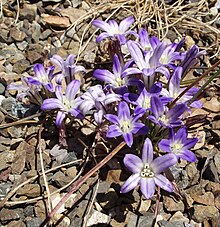Brodiaea terrestris
| Brodiaea terrestris | ||||||||||||
|---|---|---|---|---|---|---|---|---|---|---|---|---|

Brodiaea terrestris subsp. terrestris |
||||||||||||
| Systematics | ||||||||||||
|
||||||||||||
| Scientific name | ||||||||||||
| Brodiaea terrestris | ||||||||||||
| Kellogg |
Brodiaea terrestris is a species of the genus Brodiaea in the asparagus family (Asparagaceae). The two subspecies are only found in the western US states of California and Oregon.
description
Vegetative characteristics
Brodiaea terrestris grows as perennial herbaceous plants . Plant tubers are formed as persistence organs . One to six narrow leaves are produced per tuber during the growing season.
Generative characteristics
The slender inflorescence stem is only 0.5 to 20 centimeters long. At the end of the inflorescence stem there is an open, golden inflorescence . The bracts also covers during the inflorescence still in bud one is not complete. There are also cover sheets . The flower stalk is 1 to 15 inches long.
The hermaphrodite flowers are radial symmetry and threefold. There are two circles, each with three bracts , which are fused at their base. The three outer bracts are slightly narrower than the inner three. The six pink-purple or rose-colored bracts are fused into a narrow, bell-shaped, opaque flower tube with a length of 6 to 13 centimeters, which does not open until the fruit is ripe. The corolla is 16 to 33 millimeters long and the free part of the bracts is usually more than twice as long as the flower tube. The free part of the bracts is spread out at a length of 10 to 20 millimeters and bent back at the upper end. In Brodiaea californica there are three sterile stamens, i.e. staminodes , that are fused with the bloom bracts and resemble small petals and each face the outer bracts. In the slightly inwardly inclined, but not touching the stamens, purple to whitish and with a width of 4 to 5 millimeters linear staminodes, the edges are 1/4 rolled up and the upper end is relatively wide and somewhat hood-like and notched. The three fertile stamens are located opposite the inner bracts and also fused at the base of the envelope. The base of the 2 to 3 millimeter long stamens is widespread, but forms a triangular wing. The size and shape of the stamens and the structures at the base of the stamens are important determinants for the Brodiaea species. The anthers are linear with a length of 3 to 6 millimeters and the ends do not touch. Three carpels long at a 7 to 9 millimeters, three crests membered ovary grown. The 4 to 9 millimeter long stylus ends in a three-lobed scar .
The egg-shaped capsule fruits open in folds = loculicide. The seeds are black.
Systematics and distribution
The first description of Brodiaea terrestris carried out in 1859 by Albert Kellogg in Proceedings of the California Academy of Sciences , Volume 2, page 6. A synonym of Brodiaea terrestris Kellogg is Hookera terrestris (Kellogg) Greene ex Britten . ,
From Brodiaea terrestris has been around since 2001, two subspecies:
- Brodiaea terrestris subsp. kernensis (Hoover) TFNiehaus (Syn .: Brodiaea coronaria . var kernensis Hoover , Brodiaea terrestris var. kernensis (Hoover) TFNiehaus , Brodiaea elegans var. australis Hoover ): She has the rank of a subspecies since 1971. It is common and widespread in central and southern California. It thrives in the grasslands, in the forests of the foothills at altitudes from 0 to 1500 meters. With a chromosome number of 2n = 48, it appears to be the octoploid form of the nominate form.
- Brodiaea terrestris Kellogg subsp. terrestris (Syn .: Brodiaea coronaria var. macropoda (Torr.) Hoover , Brodiaea grandiflora var. macropoda Torr. , Brodiaea torreyi Alph. Wood , Hookera macropoda (Torr.) Kuntze ): It occurs in California and Oregon . It thrives in forests of the foothills and in coastal prairies at altitudes from 0 to 400 meters. The chromosome number of the nominate form is 2n = 12 or 36.
Individual evidence
- ↑ a b c d e Rafaël Govaerts (Ed.): Brodiaea terrestris. In: World Checklist of Selected Plant Families (WCSP) - The Board of Trustees of the Royal Botanic Gardens, Kew . Retrieved December 29, 2019.
- ↑ a b c d e f g J. Chris Pires: In: Flora of North America Editorial Committee (Ed.): Flora of North America North of Mexico. Volume 26: Magnoliophyta: Liliidae: Liliales and Orchidales , Oxford University Press, New York and Oxford, 2002, ISBN 0-19-515208-5 . Brodiaea terrestris , p. 327 - online with the same text as the printed work .
- ↑ Brodiaea terrestris in the Germplasm Resources Information Network (GRIN), USDA , ARS , National Genetic Resources Program. National Germplasm Resources Laboratory, Beltsville, Maryland. Retrieved December 29, 2019.
- ↑ a b c d e f J. Chris Pires, Robert E. Preston: Brodiaea , 2012: Brodiaea terrestris data sheet in Jepson Flora Project (ed.): Jepson eFlora .
- ↑ a b Brodiaea terrestris at Tropicos.org. Missouri Botanical Garden, St. Louis, accessed December 29, 2019.
Web links
- Data sheet of Brodiaea terrestris at Pacific Bulb Society with detailed photos. last accessed on December 29, 2019.
- USDA profiles with distribution map.
- Digitized herbarium specimens from representatives of the genus Brodiaea .
- Datasheet of Brodiaea terrestris at Calflora Database with distribution map and photos.

